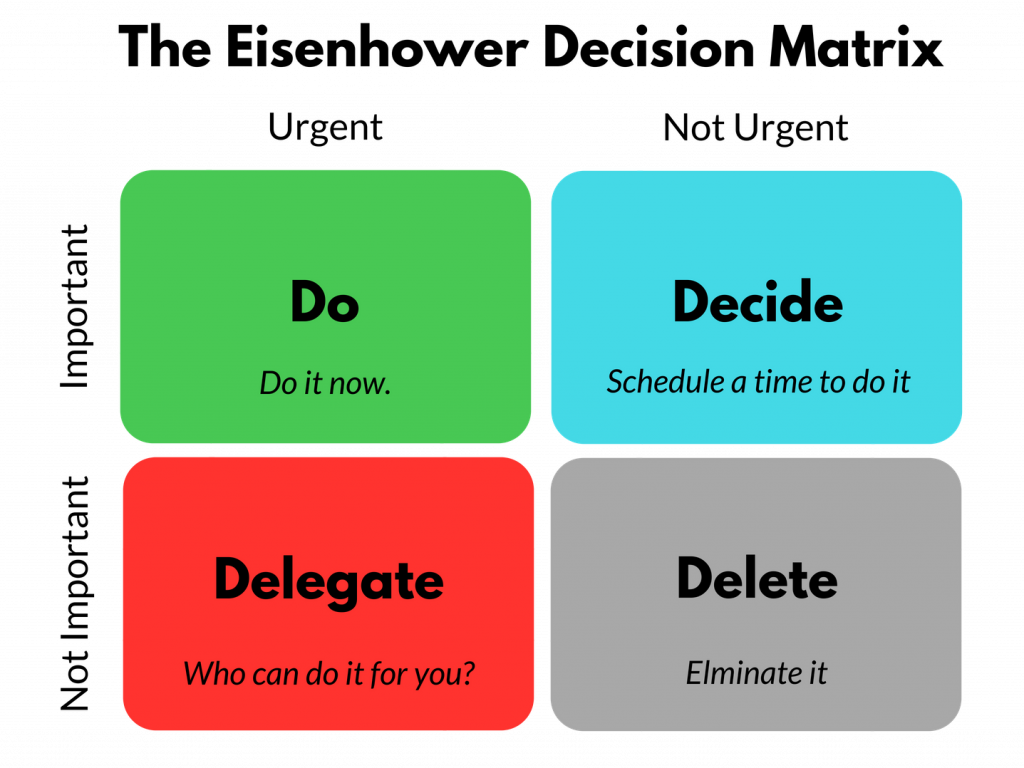How can a business effectively manage their time
Time is one of the most valuable resources a business can have, yet it’s often in short supply. With so many tasks and priorities to juggle, it’s easy for business owners and employees to feel overwhelmed and fall behind. However, with effective time management strategies, businesses can make the most of their time and achieve their goals more efficiently. In this post, we’ll share some tips on how to effectively manage your time as a business. If you are a business looking for a coach or mentor then Reboot Coaching offers 30 min free taster sessions, you can sign up here.
Set Priorities
Setting priorities is an important aspect of effective time management for businesses. Prioritizing involves determining the tasks and activities that are most important and urgent, and allocating time and resources accordingly. By doing so, businesses can ensure that they are focusing their time and energy on tasks that are essential to their success.
To set priorities, businesses should first identify their goals and objectives. This could include short-term goals such as completing a project or meeting a deadline, as well as long-term goals such as increasing revenue or expanding their customer base. Once goals are identified, businesses should determine the tasks and activities that are necessary to achieve these goals.
One helpful tool for setting priorities is a to-do list. A to-do list can help businesses keep track of all the tasks that need to be accomplished, and prioritize them based on their importance and urgency. When creating a to-do list, businesses should be specific and realistic about what they can accomplish within a given timeframe.
Another useful approach for setting priorities is the Eisenhower Matrix. This matrix divides tasks into four categories based on their importance and urgency:
Urgent and important – these tasks should be done first and given top priority.
Important but not urgent – these tasks should be scheduled and given a specific deadline.
Urgent but not important – these tasks should be delegated to someone else if possible.
Not urgent and not important – these tasks can be eliminated or postponed.
By using the Eisenhower Matrix or a similar method, businesses can prioritize their tasks and ensure that they are focusing their time and resources on the most important and urgent tasks.
Use Time-Blocking
Time-blocking is a popular time management technique that involves scheduling specific blocks of time for different tasks or activities. By breaking up the workday into focused blocks of time, businesses can improve productivity, reduce distractions, and better manage their time. Here are some ways businesses can use time-blocking to enhance their time management strategies:
Determine your top priorities: Before you begin time-blocking, it’s important to determine your top priorities. This could include important deadlines, meetings, or other high-priority tasks that require your immediate attention. Once you’ve identified your priorities, you can begin to schedule time blocks around them.
Create a schedule: Use a planner, calendar, or scheduling tool to create a daily or weekly schedule that includes specific time blocks for each task or activity. Be sure to include breaks and downtime as well. Try to schedule your most important and challenging tasks during your most productive hours.
Be realistic: When time-blocking, it’s important to be realistic about how much time each task will take. Overestimating or underestimating the time required for a task can throw off your entire schedule. Consider the complexity of the task, your experience with it, and any potential obstacles or interruptions that may arise.
Focus on one task at a time: Time-blocking encourages focus and concentration on one task at a time. Avoid multitasking, as it can actually decrease productivity and increase stress levels. Instead, devote your full attention to the task at hand during each time block.
Minimize distractions: During your time blocks, minimize distractions as much as possible. Turn off notifications on your phone and computer, close unnecessary tabs or programs, and communicate with coworkers or employees that you are not to be disturbed during certain periods.
Evaluate and adjust: After a week or two of time-blocking, evaluate your schedule and adjust it as necessary. You may find that some tasks take longer or shorter than expected, or that certain time blocks are not as productive as others. Be flexible and willing to make changes as needed.
In conclusion, time-blocking is a valuable tool for businesses looking to manage their time more effectively. By scheduling specific time blocks for each task, businesses can increase productivity, reduce distractions, and stay on track with their priorities. With practice and consistency, time-blocking can become an essential part of a successful time management strategy.
Avoid Distractions
Avoiding distractions is a crucial aspect of effective time management for businesses. Distractions can take many forms, such as email notifications, social media notifications, phone calls, or interruptions from coworkers or employees. Here are some ways businesses can avoid distractions and stay focused:
Identify and eliminate distractions: The first step in avoiding distractions is to identify them. Consider what types of distractions are most common in your work environment, and take steps to eliminate them. This could include turning off notifications on your phone or computer, closing unnecessary tabs or programs, or putting up a “Do Not Disturb” sign when you need uninterrupted time to focus.
Establish boundaries: Communicate your boundaries to coworkers or employees, and let them know when you are not to be disturbed. This could include scheduling specific time blocks for meetings or collaboration, and designating other times as “quiet time” for focused work.
Take breaks: Taking regular breaks throughout the workday can help prevent burnout and increase productivity. Use your breaks to recharge and refocus, and avoid the temptation to check email or social media during this time.
Create a conducive work environment: Creating a work environment that is conducive to productivity can help minimize distractions. This could include using noise-cancelling headphones, creating a designated workspace that is free from clutter and distractions, or using productivity tools such as white noise machines or focus apps.
However, it’s important to note that avoiding distractions should not be taken to an extreme. It’s important to maintain a healthy work-life balance, and taking breaks and interacting with coworkers or employees can be important for overall productivity and job satisfaction. Additionally, completely eliminating all distractions may not be possible or desirable in all work environments.
Delegate Tasks
Delegating tasks is an important aspect of time management for businesses. By delegating tasks, managers and business owners can free up their time to focus on higher-level tasks that require their expertise and strategic thinking. Here are some tips for effective delegation:
Identify tasks that can be delegated: The first step in delegating tasks is to identify tasks that can be delegated. This could include tasks that are routine, time-consuming, or outside of your area of expertise.
Choose the right person for the task: When delegating tasks, it’s important to choose the right person for the job. Consider the person’s skills, experience, and workload, and choose someone who is capable of completing the task successfully.
Provide clear instructions: When delegating tasks, provide clear instructions and expectations for what needs to be done. Be specific about the task requirements, deadlines, and any other relevant details.
Set up checkpoints: To ensure that the task is on track, set up checkpoints or progress reviews at regular intervals. This can help identify any issues or challenges early on, and allow for adjustments to be made as needed.
Trust your team: Delegating tasks requires trust in your team. Trust that they have the skills and expertise to complete the task successfully, and avoid micromanaging or second-guessing their decisions.
Provide feedback: Once the task is completed, provide feedback to the person who completed it. Acknowledge their efforts and provide constructive feedback to help them improve their performance in the future.
Delegating tasks is an important aspect of time management for businesses. By identifying tasks that can be delegated, choosing the right person for the job, providing clear instructions, setting up checkpoints, trusting your team, and providing feedback, businesses can free up their time to focus on higher-level tasks and increase productivity. Effective delegation can also help develop the skills and expertise of your team members, leading to a more capable and empowered workforce.
Take Breaks
Taking breaks is an important aspect of time management for businesses. It may seem counterintuitive, but taking regular breaks throughout the workday can actually increase productivity and creativity. By stepping away from work for a short period of time, employees can recharge their energy and refocus their attention, leading to better concentration and more effective problem-solving. Breaks can take many forms, such as going for a walk, grabbing a coffee, or simply taking a few minutes to stretch or meditate. Incorporating breaks into your workday can help prevent burnout, reduce stress, and improve overall job satisfaction.
A study by ItNux (Read more here) found a number of interesting statistics about taking breaks at work, they found that just 29 minutes spent outdoors results in a 45% increase in productivity. And breaks can combat workplace burnout: 59% of employees say more breaks would improve their work happiness, and 43% say it would boost their personal happiness. Additionally, 37% say regular breaks during the day would improve their health. So overall taking regular breaks have huge benefits to a business.
Learn to Say No
Saying no to unnecessary tasks or requests can help you focus on your priorities. It’s okay to say no to requests that don’t align with your goals or values. Be respectful, but assertive in your responses.
Learning to say no is a crucial aspect of effective time management for businesses. Saying yes to every request or opportunity that comes your way can quickly lead to overwhelm and burnout. By learning to say no, you can prioritize your time and energy on the tasks and projects that are most important and relevant to your goals. This can also help you maintain boundaries and avoid taking on tasks or responsibilities that are outside of your scope or expertise. Saying no can be difficult, especially if you are used to saying yes to everything. However, by setting clear priorities and communicating your boundaries effectively, you can learn to say no in a way that is respectful and professional.
Use Technology
Using technology is an important aspect of time management for businesses. Technology can help automate routine tasks, streamline processes, and improve overall efficiency. Here are some ways that businesses can use technology to improve time management:
Project management tools: Project management tools such as Trello, Asana, and Basecamp can help businesses manage tasks, deadlines, and team collaboration in an organized and efficient way.
Time-tracking software: Time-tracking software such as Toggl, RescueTime, and Harvest can help businesses track the time spent on various tasks and projects, which can help identify areas for improvement and increase productivity.
Communication tools: Communication tools such as Slack, Microsoft Teams, and Zoom can help businesses stay connected and communicate effectively, regardless of location or time zone.
Automation tools: Automation tools such as Zapier, IFTTT, and Microsoft Flow can help automate routine tasks and workflows, such as email notifications, social media posting, and data entry.
Cloud storage: Cloud storage services such as Google Drive, Dropbox, and OneDrive can help businesses store and access documents and files from anywhere, which can improve collaboration and streamline workflows.
While technology can be a valuable tool for time management, it’s important to use it strategically and not become overwhelmed by the sheer number of options available. Choose technology tools that are relevant to your specific needs and goals, and take the time to learn how to use them effectively. With the right technology tools in place, businesses can increase productivity, reduce administrative overhead, and achieve greater success in less time.
In conclusion, time management is crucial for businesses to succeed. By setting priorities, using time-blocking, avoiding distractions, delegating tasks, taking breaks, learning to say no, and using technology, businesses can make the most of their time and achieve their goals more efficiently. Implement these tips and watch your productivity soar.











